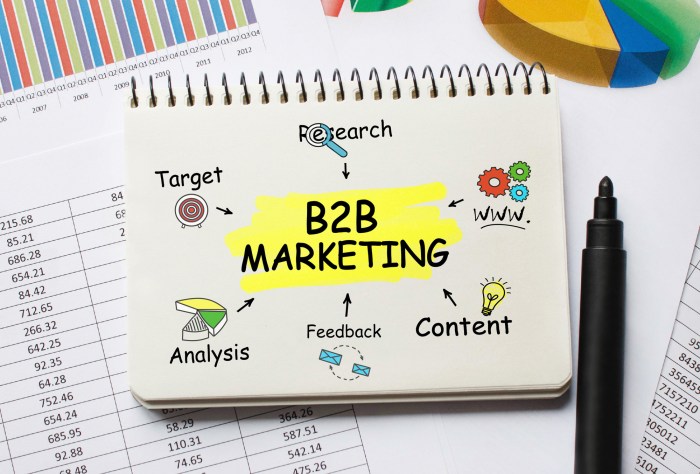Creating B2B Marketing Campaigns sets the stage for this enthralling narrative, offering readers a glimpse into a story that is rich in detail with american high school hip style and brimming with originality from the outset.
In this guide, we will delve into the key aspects of B2B marketing campaigns, from understanding the target audience to crafting compelling content and leveraging data and analytics to optimize success.
Overview of B2B Marketing Campaigns
B2B marketing campaigns are strategies designed to promote products or services from one business to another. Unlike B2C marketing that targets individual consumers, B2B campaigns focus on building relationships and providing solutions to other businesses. These campaigns often involve more complex sales cycles and decision-making processes.
Examples of Successful B2B Marketing Campaigns
- Adobe’s “CMO.com” platform provides valuable resources and content for marketing professionals, positioning Adobe as a thought leader in the industry.
- Salesforce’s “Trailhead” program offers free online training and certification courses to educate users about their products and services, driving engagement and loyalty.
- HubSpot’s “Inbound Marketing Methodology” has become a staple in the marketing industry, attracting businesses with its focus on creating valuable content and building relationships.
The Importance of Creating Targeted B2B Campaigns
Targeted B2B campaigns are crucial for reaching the right audience with relevant messaging. By understanding the specific needs and pain points of businesses in a particular industry or segment, marketers can tailor their campaigns to resonate with decision-makers and influencers. This approach increases the likelihood of generating high-quality leads and driving conversions, ultimately leading to a more successful marketing strategy.
Understanding the Target Audience

In B2B marketing, understanding the target audience is crucial for the success of any campaign. By identifying key characteristics and conducting thorough research, marketers can tailor their strategies to meet the specific needs of their B2B clients.
Key Characteristics of a Target Audience
- Industry: Understanding the industry in which the target audience operates helps marketers speak their language and address specific pain points.
- Company Size: The size of the company can impact decision-making processes and budget allocations, influencing the marketing approach.
- Decision-Makers: Identifying key decision-makers within the organization is essential for targeting the right individuals with the right messaging.
- Challenges and Pain Points: Knowing the challenges and pain points of the target audience allows marketers to position their products or services as solutions to these issues.
Conducting Research for B2B Clients
- Surveys and Interviews: Engaging with current and potential clients through surveys and interviews can provide valuable insights into their needs and preferences.
- Data Analysis: Analyzing data from CRM systems and other sources can help identify trends and patterns that inform marketing strategies.
- Competitor Analysis: Studying competitors can reveal gaps in the market and opportunities to differentiate from others in the industry.
Role of Buyer Personas
- Creating Personas: Developing buyer personas based on research helps marketers visualize their target audience and tailor messaging accordingly.
- Personalization: Buyer personas enable personalized marketing strategies that resonate with specific segments of the target audience.
- Content Creation: Buyer personas guide the creation of content that addresses the needs and interests of different buyer types within the target audience.
Setting Clear Campaign Objectives: Creating B2B Marketing Campaigns
Setting specific objectives for B2B marketing campaigns is crucial for defining the direction and purpose of your efforts. By establishing clear and measurable goals, businesses can better track their progress and evaluate the success of their campaigns.
Aligning with Business Goals
It is essential to align campaign objectives with overall business goals to ensure that marketing efforts are contributing to the company’s success. For example, if a business objective is to increase market share, a corresponding marketing campaign objective could be to generate a certain number of leads from a specific target market.
- Increase brand awareness by achieving a certain number of impressions or reach on social media platforms.
- Generate a specific number of qualified leads through targeted email marketing campaigns.
- Drive website traffic by increasing organic search rankings for relevant s.
- Boost sales revenue by achieving a certain conversion rate from a promotional campaign.
Choosing the Right Channels and Platforms
In today’s digital age, selecting the right channels and platforms for your B2B marketing campaign is crucial for reaching your target audience effectively. Here’s how you can make the best choices:
Selecting Appropriate Channels for B2B Marketing Campaigns, Creating B2B Marketing Campaigns
When choosing channels for your B2B marketing campaign, consider where your target audience spends their time. Focus on platforms that align with your business goals and objectives. Whether it’s email marketing, social media, search engine advertising, or content marketing, make sure your channels resonate with your audience.
Role of Digital Marketing Platforms in Reaching B2B Audiences
Digital marketing platforms play a significant role in reaching B2B audiences due to their ability to target specific demographics, behaviors, and interests. Platforms like LinkedIn, Twitter, and industry-specific websites allow you to create tailored messages that speak directly to decision-makers in the B2B space.
Integrating Multiple Channels for a Cohesive B2B Campaign
To create a cohesive B2B campaign, it’s essential to integrate multiple channels effectively. By combining email marketing with social media advertising and content marketing, you can reinforce your message across various touchpoints. This omnichannel approach ensures consistent branding and messaging, increasing the likelihood of engaging your B2B audience.
Crafting Compelling Content
Creating engaging content for B2B marketing campaigns is crucial for capturing the attention of potential clients and driving conversions. Here are some tips to help you craft compelling content that resonates with your target audience.
Importance of Storytelling
Storytelling plays a vital role in B2B content creation as it helps humanize your brand and connect with your audience on a deeper level. By weaving narratives into your content, you can make complex information more relatable and memorable.
- Utilize customer success stories to showcase the real-world impact of your products or services.
- Incorporate anecdotes and personal experiences to add authenticity and emotional appeal to your content.
- Create a cohesive narrative that takes the reader on a journey, from identifying a problem to offering a solution.
Content Formats that Work Well
When it comes to B2B marketing, certain content formats are more effective in delivering your message and engaging your audience. Here are some examples of content formats that work well in B2B marketing campaigns.
- Whitepapers: In-depth reports that provide valuable insights and information on industry trends or solutions to common challenges.
- Case Studies: Detailed analyses of how your products or services have helped clients achieve their goals, showcasing your expertise and credibility.
- Webinars: Interactive online presentations that allow you to engage with your audience in real-time, providing educational content and fostering relationships.
- Infographics: Visual representations of data and information that are easy to digest and share, making complex concepts more accessible.
Leveraging Data and Analytics

In B2B marketing campaigns, data and analytics play a crucial role in optimizing strategies and measuring success. By leveraging data insights and analytics tools, businesses can make informed decisions and continuously improve their marketing efforts.
Role of Data in Optimizing B2B Marketing Campaigns
Data allows B2B marketers to understand their target audience better, identify trends, and track the performance of their campaigns. By analyzing data such as website traffic, email open rates, and social media engagement, marketers can tailor their strategies to resonate with their audience and achieve better results.
- Utilizing customer relationship management (CRM) data to personalize content and messaging
- Tracking key metrics like conversion rates, lead generation, and customer acquisition costs
- Segmenting data to target specific industries, company sizes, or job roles
Measuring Effectiveness with Analytics
Analytics tools provide valuable insights into the performance of B2B marketing campaigns, allowing marketers to track ROI, identify areas for improvement, and make data-driven decisions to optimize their strategies.
“Analytics help marketers understand what is working and what needs to be adjusted to achieve the desired outcomes.”
- Monitoring website traffic and user behavior to optimize conversion funnels
- Tracking email engagement metrics such as open rates, click-through rates, and conversions
- Measuring the impact of social media campaigns through reach, engagement, and lead generation
Key Performance Indicators (KPIs) for B2B Marketing Success
Key performance indicators are essential for evaluating the success of B2B marketing campaigns and determining the return on investment. These KPIs help businesses measure the effectiveness of their strategies and make data-driven decisions to drive growth.
“By setting clear KPIs, businesses can track progress, optimize their campaigns, and achieve their marketing goals.”
- Conversion rate: Percentage of website visitors who take a desired action
- Customer acquisition cost (CAC): Cost associated with acquiring a new customer
- ROI: Return on investment from marketing efforts
Budgeting and Resource Allocation
When it comes to B2B marketing campaigns, budgeting and resource allocation play a crucial role in determining the success of your efforts. It’s essential to have a clear strategy in place to make the most out of your resources and budget.
Strategies for Budgeting Effectively
Effective budgeting is key to ensuring that your B2B marketing campaigns are successful. Here are some strategies to help you budget effectively:
- Set clear goals and objectives to align your budget with your campaign’s objectives.
- Allocate budget based on the channels and platforms that are most effective for reaching your target audience.
- Regularly review and adjust your budget based on the performance of your campaigns to optimize spending.
Importance of Allocating Resources Wisely
Allocating resources wisely is crucial in B2B marketing to ensure that you are maximizing the impact of your efforts. Here’s why resource allocation is important:
- By allocating resources strategically, you can focus on channels and tactics that are most effective in reaching your target audience.
- Effective resource allocation helps in avoiding wastage and optimizing the use of available resources.
- It allows you to scale your marketing efforts efficiently and achieve better ROI.
Tips for Maximizing ROI with a Limited Budget
Maximizing ROI with a limited budget requires smart planning and execution. Here are some tips to help you make the most out of your resources:
- Focus on high-impact activities that align with your campaign objectives to ensure maximum ROI.
- Leverage cost-effective digital marketing channels such as social media and content marketing to reach your target audience without overspending.
- Regularly analyze and optimize your campaigns to identify areas where you can cut costs and improve ROI.





